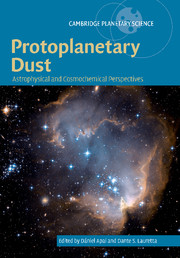Book contents
- Frontmatter
- Contents
- List of contributing authors
- Preface
- Acknowledgments
- 1 Planet formation and protoplanetary dust
- 2 The origins of protoplanetary dust and the formation of accretion disks
- 3 Evolution of protoplanetary disk structures
- 4 Chemical and isotopic evolution of the solar nebula and protoplanetary disks
- 5 Laboratory studies of simple dust analogs in astrophysical environments
- 6 Dust composition in protoplanetary disks
- 7 Dust particle size evolution
- 8 Thermal processing in protoplanetary nebulae
- 9 The clearing of protoplanetary disks and of the proto-solar nebula
- 10 Accretion of planetesimals and the formation of rocky planets
- Appendix 1 Common minerals in the Solar System
- Appendix 2 Mass spectrometry
- Appendix 3 Basics of light absorption and scattering theory
- Glossary
- Index
10 - Accretion of planetesimals and the formation of rocky planets
Published online by Cambridge University Press: 24 February 2010
- Frontmatter
- Contents
- List of contributing authors
- Preface
- Acknowledgments
- 1 Planet formation and protoplanetary dust
- 2 The origins of protoplanetary dust and the formation of accretion disks
- 3 Evolution of protoplanetary disk structures
- 4 Chemical and isotopic evolution of the solar nebula and protoplanetary disks
- 5 Laboratory studies of simple dust analogs in astrophysical environments
- 6 Dust composition in protoplanetary disks
- 7 Dust particle size evolution
- 8 Thermal processing in protoplanetary nebulae
- 9 The clearing of protoplanetary disks and of the proto-solar nebula
- 10 Accretion of planetesimals and the formation of rocky planets
- Appendix 1 Common minerals in the Solar System
- Appendix 2 Mass spectrometry
- Appendix 3 Basics of light absorption and scattering theory
- Glossary
- Index
Summary
Abstract Here we describe the formation of rocky planets and asteroids in the context of the planetesimal hypothesis. Small dust grains in protoplanetary disks readily stick together forming millimeter-to-centimeter-sized aggregates, many of which experience brief heating episodes causing melting. Growth to kilometer-sized planetesimals might proceed via continued pairwise sticking, turbulent concentration, or gravitational instability of a thin particle layer. Gravitational interactions between planetesimals lead to rapid runaway and oligarchic growth forming lunar to Marssized protoplanets in 105 to 106 years. Giant impacts between protoplanets form Earth-mass planets in 107 to 108 years, and occasionally lead to the formation of large satellites. Protoplanets may migrate far from their formation locations due to tidal interactions with the surrounding disk. Radioactive decay and impact heating cause melting and differentiation of planetesimals and protoplanets, forming ironrich cores and silicatemantles, and leading to some loss of volatiles. Dynamical perturbations from giant planets eject most planetesimals and protoplanets from regions near orbital resonances, leading to Asteroid Belt formation. Some of this scattered material will collide with growing terrestrial planets, altering their composition as a result. Numerical simulations and radioisotope dating indicate that the terrestrial planets of the Solar System were essentially fully formed in 100–200 million years.
The formation of rocky planets marks the last stage in the evolution of a protoplanetary disk, extending beyond the dissipation of the gas disk itself. The seeds of planet formation are micrometer-sized dust grains that make up roughly 1% of the mass of a typical protoplanetary disk. In the Solar System, some 1040 of these grains evolved into a handful of rocky planets in the space of 10–100 million years – a remarkable transformation indeed.
- Type
- Chapter
- Information
- Protoplanetary DustAstrophysical and Cosmochemical Perspectives, pp. 299 - 335Publisher: Cambridge University PressPrint publication year: 2010
- 5
- Cited by

